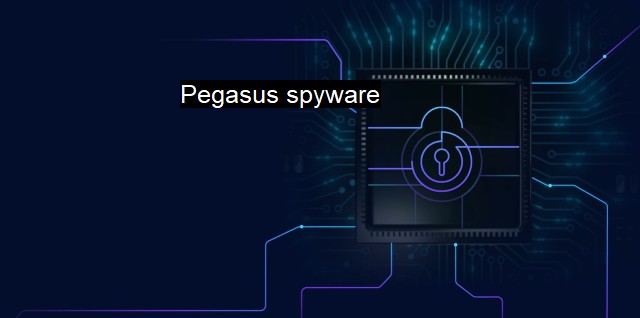What is Pegasus spyware?
Pegasus Spyware: The Invasive Threat to Cybersecurity" - A Comprehensive Overview on NSO Group's Powerful Hack and its Devastating Ability to Infiltrate Any Smarphon
Pegasus spyware represents one of the most advanced examples of malicious surveillance software available. The product of Israel's NSO Group, a cybersecurity company, Pegasus has gained notoriety globally for its remarkable capabilities as a spyware tool. Designed to infiltrate smartphones, Pegasus gives the user unfettered access to everything available on the infiltrated device.It is worth noting that Pegasus is not the sort of malware one might accidentally download via an unsafe website or email link. It is targeted adware largely monopolized by governments and intelligence agencies worldwide. The tool is voicelessly installed on targeted devices then gives access to personal data, text messages, emails, social media activity, call logs, and even allows the control of the device's microphone and camera for further surveillance.
Pegasus spyware can infiltrate both Android and iOS devices by exploiting security weaknesses or via a method known as mobile spear-phishing, whereby the targeted individual is tricked into clicking on a malicious link. Once the software infects the device, it embeds deep within the device's infrastructure, making it almost impossible for the user to detect it or for common antivirus software to eliminate it.
Pegasus renders as an astounding tool for surveillance and offensive cyber espionage where information is the ultimate power. To curb the risks posed by such potent cyber espionage tool, severe regulations are put to govern its sale and use. revelations of its misuse by several government entities around the world to spy on journalists, activists, and political opponents highlight its dark, contentious side.
Despite being flagged by leading cybersecurity enterprises as one of the most powerful espionage tools, guarding against the Pegasus spyware isn't a straightforward task. Owing to this spyware's sophistication, typical antivirus software proves largely ineffective against it. Pegasus is designed to bypass such barriers and remain undetected, even by the sophisticated security systems employed by tech giants such as Google and Apple.
The cryptographic signing of apps, frequent security updates, and the marked distinction between apps running in user space and system space have been features in the development of mobile devices that do slow down the attackers, nonetheless. Yet, the cat-and-mouse game between cybercriminals always seeking vulnerabilities and the cybersecurity industry continually patching them is still a significant problem.
Since traditional antivirus software strategies fail to capture threats posed by Pegasus, reliance on threat intelligence – legwork performed by security researchers to anticipate new attacks and respond accordingly – becomes paramount. Security providers need to monitor for signs of infection and guide prompt action. It also underscores the importance of comprehensive digital protection, including VPNs and secure, encrypted communications.
In the face of such tenacious threats like Pegasus, cybersecurity strategies should focus on not just on defense and detection, but recovery and response as well. Beyond creating defenses against known threats, middleware technologies can interdict and minimize attacks before they exploit vulnerabilities.
Competent digital hygiene, a comprehensive cybersecurity plan, and strong legal regulation governing the use and abuse of technologies like Pegasus, takes a front seat. As cybercrime continues to evolve in sophistication and ubiquity, striking the tricky balance between privacy, security, and digital freedom must form the cornerstone of our collective cybersecurity strategy. While tools like Pegasus undeniably possess significant utility in matters of national security and high-level crime detection, their potential for misuse underscores the dire need for a responsible, transparent, and ethics-bound cybersecurity landscape.

Pegasus spyware FAQs
What is Pegasus spyware?
Pegasus is a type of spyware that infects mobile devices, allowing an attacker to gain access to personal data, messages, and location information. It was developed by the Israeli cybersecurity firm NSO Group and has been used by governments to target individuals as part of surveillance operations.How can I detect if my device has been infected with Pegasus spyware?
It can be difficult to detect Pegasus spyware as it often operates silently in the background. However, there are a few indicators to look out for, such as increased battery usage, unusual amounts of data usage, and unexplained or unusual behavior on your device. You can also use antivirus software or mobile security apps to scan your device for any signs of infection.How can I protect my device from Pegasus spyware and other types of malware?
To protect your device from Pegasus spyware and other types of malware, it's important to keep your device's software and security features up-to-date. Avoid clicking on suspicious links, downloading apps from untrusted sources, and connecting to unsecured Wi-Fi networks. Additionally, using antivirus software or mobile security apps can help protect your device from malware infections.What should I do if my device has been infected with Pegasus spyware?
If you suspect that your device has been infected with Pegasus spyware, the first step is to take it offline and disconnect it from any networks or Wi-Fi connections. You should then contact a cybersecurity expert or your device's manufacturer for assistance in identifying and removing the spyware. It's also important to change all of your passwords and enable two-factor authentication on your accounts to prevent further unauthorized access.| | A | | | B | | | C | | | D | | | E | | | F | | | G | | | H | | | I | | | J | | | K | | | L | | | M | |
| | N | | | O | | | P | | | Q | | | R | | | S | | | T | | | U | | | V | | | W | | | X | | | Y | | | Z | |
| | 1 | | | 2 | | | 3 | | | 4 | | | 7 | | | 8 | | |||||||